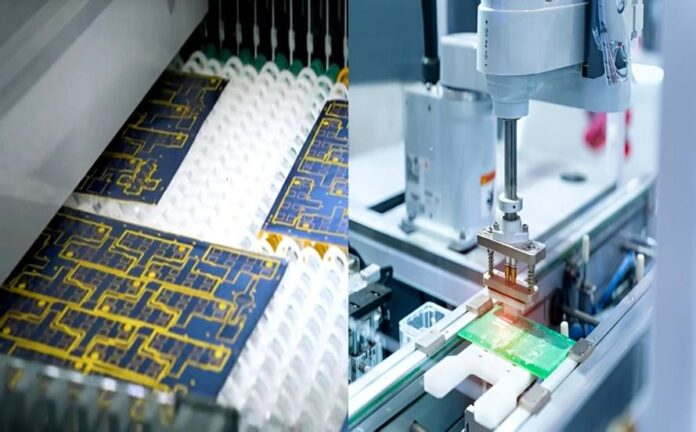A Heavy Copper PCB is a specialized type of printed circuit board designed with significantly thicker copper layers than standard PCBs. While typical PCBs feature copper thicknesses of around 1 oz/ft², heavy copper boards range from 3 oz to over 20 oz per square foot. This extra copper enhances current-carrying capacity, improves heat dissipation, and increases mechanical strength, making it ideal for power electronics, automotive systems, industrial machinery, and renewable energy applications.
What Is a Heavy Copper PCB?
A Heavy Copper PCB is defined by its use of copper conductors with a thickness exceeding 3 oz per square foot on the inner or outer layers. These boards are specifically engineered to handle high power and heat loads that standard PCBs cannot withstand. The thick copper traces enable efficient power distribution, reduce voltage drop, and enhance the reliability of high-current circuits.
The manufacturing process of a heavy copper PCB involves advanced plating and etching techniques that ensure even copper deposition across layers without compromising trace accuracy.
Key Features of Heavy Copper PCB
The Heavy Copper PCB is built to meet demanding performance standards across multiple industrial and electronic domains. Some of its notable features include:
- High Current Capacity: Thicker copper layers enable the PCB to handle larger electrical currents without overheating.
- Excellent Heat Dissipation: Ideal for applications involving power converters, inverters, and amplifiers where heat management is critical.
- Enhanced Mechanical Strength: Provides robust structural integrity, ensuring the board can withstand thermal and mechanical stress.
- Compact Power Design: Reduces the need for large heat sinks or multiple layers by efficiently managing power distribution within a smaller footprint.
- Improved Reliability: Ensures long-term durability, especially in harsh environmental or industrial conditions.
Applications of Heavy Copper PCB
A Heavy Copper PCB is a crucial component in industries that require efficient power handling and thermal stability. Its use spans across a wide range of applications, including:
- Power Electronics: Used in power converters, motor controllers, and battery management systems for efficient energy flow.
- Automotive Industry: Essential in electric vehicles, hybrid systems, and power steering modules that demand stable current distribution.
- Renewable Energy Systems: Supports high-power circuits in solar inverters, wind turbine controllers, and energy storage systems.
- Industrial Equipment: Integral to heavy machinery, welding machines, and robotics that operate under high current loads.
- Aerospace and Defense: Ensures robust electrical connections in mission-critical and high-temperature environments.
Design Considerations for Heavy Copper PCB
Designing a Heavy Copper PCB requires careful planning to balance performance and manufacturability. Some critical design considerations include:
1. Copper Thickness and Width
Selecting the right copper thickness is key. It must align with the desired current capacity while maintaining manageable thermal and mechanical stress.
2. Layer Stack-Up
Heavy copper boards often use multi-layer stack-ups to distribute power efficiently. Proper spacing between layers ensures insulation and prevents short circuits.
3. Thermal Management
Due to the high power density, incorporating thermal vias, metal cores, or external heat sinks helps dissipate heat effectively.
4. Etching and Plating Precision
Advanced etching processes are essential to create smooth and consistent traces, while controlled plating ensures even copper distribution across all layers.
5. Solder Mask and Surface Finish
A durable solder mask prevents oxidation, and finishes such as ENIG or HASL enhance solderability and connection strength.
Advantages of Using Heavy Copper PCB
Adopting Heavy Copper PCB technology offers a range of benefits for modern electronic design and manufacturing:
- Higher Power Density: Enables compact designs without compromising on current handling capability.
- Thermal Resilience: Maintains stability even in high-temperature environments.
- Reduced Layer Count: Allows high-power routing on fewer layers, minimizing material and assembly costs.
- Superior Durability: Handles repeated thermal cycling and mechanical vibrations with minimal wear.
- Enhanced Design Flexibility: Supports integration of both power and signal circuits on a single board.
Manufacturing Challenges and Quality Control
Producing Heavy Copper PCBs requires specialized expertise and precision engineering. Challenges include controlling etch depth, maintaining uniform copper distribution, and avoiding delamination during lamination. High-quality manufacturers employ advanced techniques like differential etching, step plating, and automated inspection systems to ensure flawless production.
Future of Heavy Copper PCBs
As industries shift toward higher power density systems—such as electric vehicles, renewable energy storage, and smart industrial automation—the demand for Heavy Copper PCBs continues to grow. Innovations in materials, plating chemistry, and thermal management will further enhance their performance and reliability.
Partner with a Trusted Heavy Copper PCB Manufacturer
To achieve optimal performance in your power electronics or industrial projects, it’s crucial to collaborate with an experienced Heavy Copper PCB Manufacturer. A reliable manufacturer ensures precise copper thickness control, superior thermal management, and strict quality assurance. Partnering with a professional Heavy Copper PCB Manufacturer guarantees robust circuit performance, long service life, and consistent quality—empowering your high-power applications to operate efficiently and reliably.

